
The Battle of Boyacá (1819), also known as the Battle of Boyacá Bridge was a decisive victory by a combined army of Venezuelan and New Granadan troops along with a British Legion led by General Simon Bolivar over the III Division of the Spanish Expeditionary Army of Costa Firme commanded by Spanish Colonel José Barreiro. This victory ensured the success of Bolívar's campaign to liberate New Granada. The battle of Boyaca is considered the beginning of the independence of the north of South America, and is considered important because it led to the victories of the battle of Carabobo in Venezuela, Pichincha in Ecuador, and Junín and Ayacucho in Peru. New Granada acquired its definitive independence from the Spanish Monarchy, although fighting with royalist forces would continue for years.

Lt. General José Antonio de la Caridad Maceo y Grajales was a Cuban general and second-in-command of the Cuban Army of Independence.
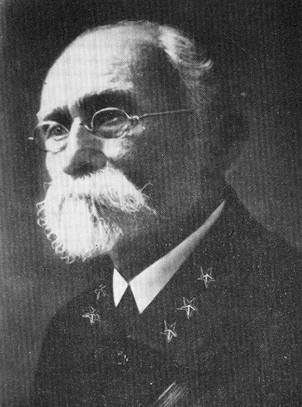
Máximo Gómez y Báez was a Dominican Generalissimo in Cuba's War of Independence (1895–1898). He was known for his controversial scorched-earth policy, which entailed dynamiting passenger trains and torching the Spanish loyalists' property and sugar plantations—including many owned by Americans. He greatly increased the efficacy of the attacks by torturing and killing not only Spanish soldiers, but also Spanish sympathizers and especially Cubans loyal to Spain. By the time the Spanish–American War broke out in April 1898, the rebellion was virtually defeated in most of Western Cuba, with only a few operating pockets in the center and the east. He refused to join forces with the Spanish in fighting off the United States, and he retired to the Quinta de los Molinos, a luxury villa outside of Havana after the war's end formerly used by captains generals as summer residence.

Cruces is a municipality and town in Cienfuegos Province, Cuba. It is the home of the Mal Tiempo National Park which commemorates a battle in the 1895 War of Independence.

The Cuban War of Independence, also known in Cuba as The Necessary War, fought from 1895 to 1898, was the last of three liberation wars that Cuba fought against Spain, the other two being the Ten Years' War (1868–1878) and the Little War (1879–1880). The final three months of the conflict escalated to become the Spanish–American War, with United States forces being deployed in Cuba, Puerto Rico, and the Philippine Islands against Spain. Historians disagree as to the extent that United States officials were motivated to intervene for humanitarian reasons but agree that yellow journalism exaggerated atrocities attributed to Spanish forces against Cuban civilians.
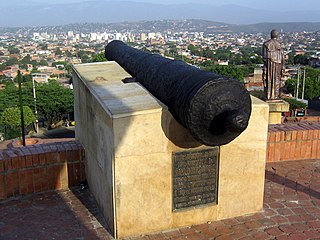
The Battle of Cúcuta was a military conflict in the Spanish American wars of independence fought on 28 February 1813 between the pro-independence forces led by Simón Bolívar and Spanish royalist troops under General Ramón Correa at the town of Cúcuta, in present-day Colombia, close to the border with Venezuela. Bolivar was victorious. The battle gained him much support and immediately preceded his march into Venezuela, later dubbed the Admirable Campaign.
The Battle of El Jobito was a military event which took place on May 13 of 1895 in Oriente Province of Cuba, in the Cuban War of Independence.
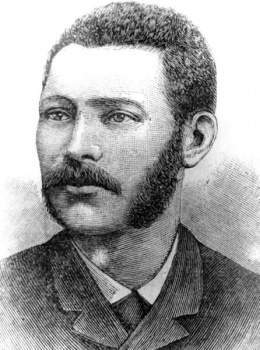
José Marcelino Maceo Grajales was a Cuban Independence Activist and patriot of the 19th Century.

The Battle of Peralejo was a military confrontation between Cuban independence rebels, under the command of Major General Antonio Maceo against the forces of the Spanish Army, under the command of Captain General Arsenio Martínez Campos, which was part of Maceo's First Eastern Campaign during the Cuban War of Independence.
The Battle of Iguará was a battle of the Cuban War of Independence which took place on December 13, 1895 in the Santa Clara Province, Cuba.
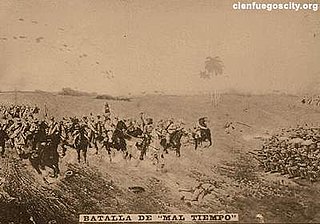
The Battle of Mal Tiempo was a battle of the Cuban War of Independence that took place on December 15, 1895, a few kilometers away from Cruces, Cienfuegos Province. In the battle, Mambises and Spanish forces faced each other, the former being victorious. This victory was considered one of the most important of the Invasion from East to West in Cuba, due to the political, military and economic consequences in favor of the independence activists.
The Battle of Coliseo was a group of military actions carried out in the surroundings of the town of the same name, Matanzas Province, Cuba on December 23, 1895 during the Cuban War of Independence.
The Battle of Calimete was a battle of the Cuban War of Independence on December 29, 1895, which was led by Cuban independence activists Máximo Gómez, Antonio Maceo and later on, Serafín Sánchez.
The Battle of Las Taironas was a battle of the Cuban War of Independence that took place on January 17, 1896 at Pinar del Río between Cuban forces led by Major General Antonio Maceo and the Spanish led by lieutenant colonel Ulpiano Sanchez Echevarria who was a Cuban native.
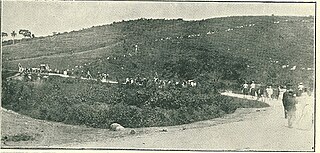
The Lanzadera Campaign was a significant part of the Cuban War of Independence as it was the next operation of the Mambises by Máximo Gómez to distract Spanish troops to him and avoiding their pressure on Antonio Maceo, who was able to continue to the West to complete the Invasion from East to West in Cuba. The campaign was considered to be one of skillful maneuvering, mobility and oversight as Gómez's vastly outnumbered 2,000 Mambises had achieved their goals with negligible losses against the 40,000 Spanish infantry which was commanded by Arsenio Martínez Campos, Sabás Marín and Valeriano Weyler.
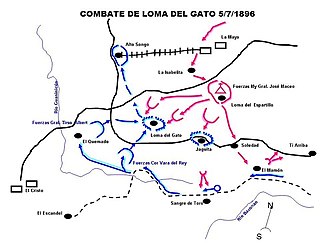
The Battle of Loma del Gato took place during the Cuban War of Independence on July 5, 1896 at Santiago de Cuba, Oriente Province. It is notable for the death of Mambí General José Maceo.
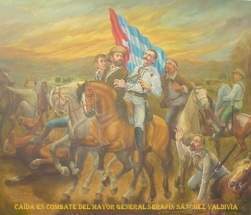
The Battle of Paso de las Damas was a battle of the Cuban War of Independence that took place on 18 November 1896 at the Santa Clara Province.
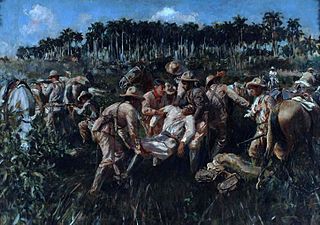
The Battle of San Pedro was a battle of the Cuban War of Independence that took place on December 7, 1896 within the vicinity of the farm of the same name. The battle occurred near the town of Punta Brava on the outskirts of Marianao, La Habana Province.

The La Reforma Campaign was a campaign of the Cuban War of Independence which was waged for 16 months with the Cuban forces under the command of Máximo Gómez against the Spanish forces under the command of Valeriano Weyler. Despite the Spanish outnumbering the Cuban forces by 40,000 to 600, Gómez's guerrilla warfare tactics as well as the weather caused over 40 Spanish soldiers to die each day throughout the campaign. His approach was to divide his forces into tiny guerrilla groups and fight alone with his General Staff while continuously moving.

The Cuban Liberation Army, colloquially known as the Mambí Army was an insurgent army which was formed in the last third of the 19th century and fought for independence from Spain and the abolition of slavery. It first saw combat in the Ten Years' War (1868-1878) under the command of Carlos Manuel de Céspedes, Ignacio Agramonte, and Carlos Roloff. The independentists were decentralized and operated within their own regions autonomously of each other, until the Assembly of Guáimaro established the Republic-in-Arms of Cuba and the Liberation Army's command structure. After the Pact of Zanjón, a brief uprising called the Little War saw Major-Generals Calixto García and Antonio Maceo lead the Army of Liberation in another attempt at independence and the abolition of slavery, though unsuccessfully. Finally, during the War of Independence, the Liberation Army was once again organized to fight against the Spanish colonial government. The Liberation Army would reach its highest count of active members in the Spanish-American War, when an imminent Cuban-American victory caused hitherto anti-independence elites to join the Liberation Army. These recruits were nicknamed "Sunflowers" because they "point to where the sun is shining".















